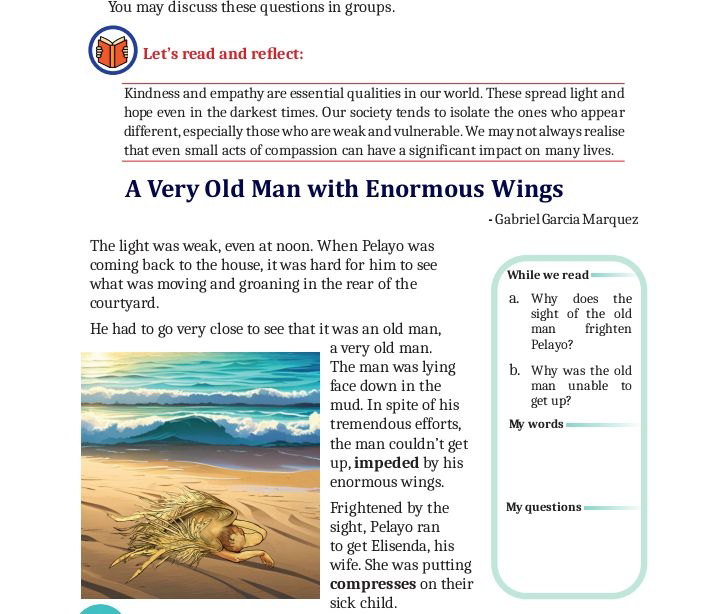Horegallu
I do think that the grandfather and Ratna were doing tremendous social service. They used to sit down and calmly listen to the problems people have. They listened to people with sympathy and no judgment. By opening theirmind, people feel relieved. The grandfather and Ratna might not have solved people’s problems. But they were simply horegallus giving the people temporary relief from their inner burdens.
We can definitely relate grandfather and Ratna to a horegallu because they helped people in unburdening themselves. A horegallu under a shady tree, sometimes with cool drinking water nearby, lets the people carrying burdens sit for a while and relax, getting back their energy. By talking to the grandfather and Ratna, people also felt relieved, Burdens are lightened when they are shared. In this sense they both are horegallus.
Mere listening can’t solve a problem. The qualities of a god listener include: attention, interest, sympathy, making agreements, giving suggestions and being non- judgmental.
Ratna: What happened, Nomita?
Nomita: He received a letter written to me by my mother. He read and left it in his pocket. After 3 days when I checked his pockets before giving the dirty clothes to the washer¬man I found it there, crumpled and torn. When I asked him why he opened my letter and even refused give it to me later, he rudely told me he would do what he wants.
Ratna: He said that!
Nomita: He did. He further asked me what I could do. I was enraged. I saw a matchbox lying near, lit a match and put it to my sari which caught fire.
Ratna: Goodness! How could you do that?
Nomita: I was mad with anger. I wanted to tell him that l ean also do things.
Ratna: And then?
Nomita: Ajit was shocked and he came running and put out the fire. I could see remorse in his face. I am sure he will not challenge me again in the future.
Ratna: But Nomita, you had gone too far in setting fire to yourself.
Nomita: Well, men sometimes need shock treatments to bring them to their senses!
2. Read the passage on page 29 and pick out the adjectives and categorize them based on the nature of their description.
Adjectives: large, flat, vertical, stone, fellow, cool, earthen, their, similar, simple, sure
Categories:
Adjectives of Quality: flat, two, vertical, stone, fellow, cool, earthen, simple, sure
Adjective of Quantity: large
Adjective of number: two
Adjective of Comparison: similar
Possessive adjective – their
Now rewrite the passage substituting the adjectives without any change in meaning:
Answer:
It was a big, level stone placed horizontally over a couple of upright ones, thus making a hard bench on which anyone could sit and rest a while, chat with a co-traveler and exchange news of the road. Cold water would be kept in clay pots near the bench and people could quench thejr thirst before starting their journeys again. I am certain the same, easy arrangements can be found in the villages all over the country.
Activity - III (Comparison)
3. In this unit, you have got acquainted with several women characters, both real and fictitious. The following excerpts present their ideas on empowerment.
“I always compare women to match boxes.” Ashapuma Debi
Tm the heat that warms the earth, which else were colder than a stone.” Katherine Tynan
“I don’t think there is a greater sin that betraying someone’s confidence.” Ratna
“For what reason should you open my letters? I told you a thousand times not to.” Nomita to Ajit
“I wish there were some horegallus on the world.” Sudha Murty
It’s time to create a world where women can meet their potential… and the world will reap the benefits.” Christine Lagarde
Now attempt a comparison of these women with regard to their ideas on being empowered.
There are six women in the above quotations giving their own views on empowerment. Ashapuma Debi thinks that women have a lot of power but they don’t utilise it properly. She feels women are like matchboxes which people keep in their kitchen, pantry, bedrooms, or even in their pockets. Katherine Tynan is sympathetic and kind. She is the epitome of a good mother, who gives her children unconditional love. SW thinks that only women have the power to give such love and warmth to the family members. Ratna is also sympathetic and she listens to the problems of others.
She never tells the secrets of those who trust her and tell her of their problems. Nomita wants to be independent, but her husband does not allow her to be so. She is severe and resentful of her husband’s behaviour but she can hardly change him. Sudha Murty wants people to be horegallus so that they can share the burden of others. Christine Lagarde wants women to work for meeting their potential. She feels women are denied opportunities in education, jobs and also leadership positions. She is very domineering and she wants women to assert themselves against all kinds of discrimination against them.
Activity - VI (Review)
Prepare a review of the films which influenced you the most.
(Hints: theme, screenplay, cast and credit, music, cinematography, etc.)
Bhargavinilayam
An enthusiastic and talented novelist (Madhu) comes to stay in a desolate mansion named Bhargavi Nilayam. The novelist and his servant Cheriya Pareekkanni (Adoor Bhasi) experience the presence of a strange entity here. They come to know from the local people that it is a haunted house. The story is that it is haunted by the ghost of the daughter of the previous owner. The novelist and his servant encounter strange happenings here – the gramophone plays on its own, objects move around. The novelist finds some old letters written to Bhargavi (Vijaya Nirmala) by her lover Sasikumar (Prem Nazir). It is believed that the ghost of Bhargavi now haupts this house.
The letters give some indication about their love affair and their tragic deaths. The novelist decides to probe the matter. He starts writing the story of Bhargavi. The information gathered from the local people and the hints in the letters help him in his writing. The story develops. Bhargavi falls in love with her neighbour Sasikumar who is a talented poet and singer. Bharagavi’s father’s nephew, Nanukuttan (P. J. Antony) is also in love with Bhargavi. But Bhargavi hates Nanukuttan who is a bad man. Nanukuttan tries all nasty tricks to separate the lovers. He kills Sasikumar. Bharagavi becomes furious when she comes to know of her lover’s murder. In a scuffle Nanukuttan pushes Bhargavi into a well, killing her. Nanukuttan spreads the news that Bhargavi had committed suicide.
The novelist reads out the story to the ghost who by now has become quite compassionate with him. Nanukuttan overhears the story. He fears that once the story is published the truth behind the death of Bhargavi and Sasikumar will be out. He attacks the novelist and a fight ensues. During the fight both Nanukuttan and the novelist reach the well in which Bharagavi was drowned. While trying to push the novelist into the well, Nanukuttan loses his balance. He falls into the well and is killed, while the novelist escapes. The novelist then prays for the peace of Bhargavi’s soul and the movie ends with the laugh of Bhargavi.
Bhargavinilayam means The House of Bhargavi’. It is a 1964 Malayalam horror-romance film written by Vaikom Muhammed Basheer and directed by A. Vincent. The film stars Prem Nazir, Madhu and Viiava Nirmala in the lead roles. Its story, screenplay and dialogues are written by Vaikom Muhammad Basheer. It was the directorial debut of noted cinematographer A. Vincent. The film is especially noted for its music by M. S. Baburaj. It was the first horror film in Malayalam and was one of the biggest hit films of all time.
Activity VII (Let’s edit)
Given below is the opening paragraph of a review prepared by a student of Class XII. There are a few errors in it Identify them and refine the paragraph.
Gone With The Wind
One of the classic films that define American cinema, Gone with the Wind, is a rare example of a collaboration involving hundreds of talents and the film turned out great. For millions of people, Gone with the Wind, has helped to define the myth and reality of the country’s most tragic period in history – the Civil War and Reconstruction. The popularity oflVIargaret Mitchell’s bestselling novel allowed the filmmaker to be confident of its success. Of course, proper attention to costumes and sets was paid. The film’s visual effects – especially the burning of Atlanta – are indeed effective and memorable.
Gone with the Wind deserves the label epic. It presents enough detail to be a facsimile of reality.



Comments
Post a Comment
Please share your feedback and questions